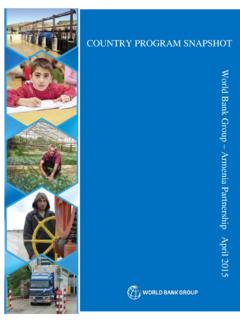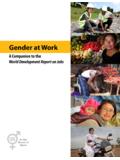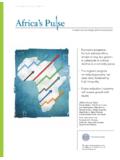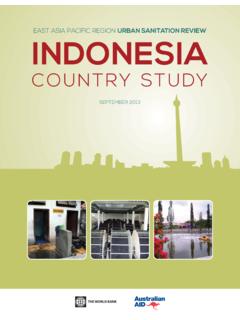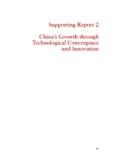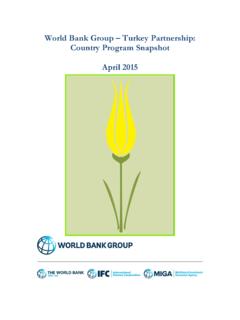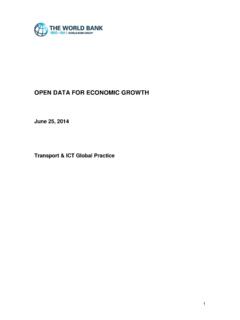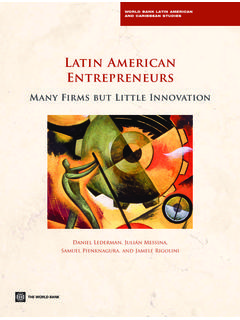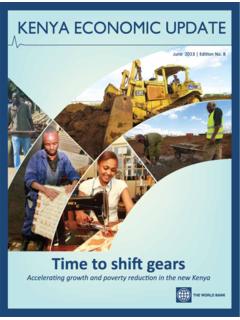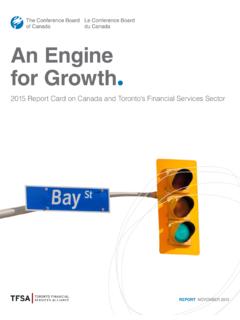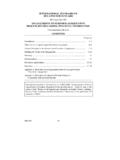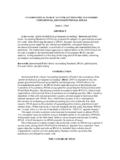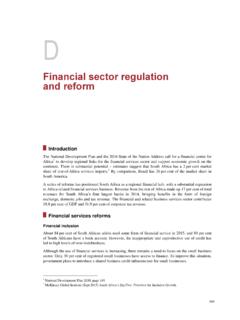Transcription of World Bank's Financial Sector Assessment for China
1 SecM2011-0492 November 2011 China FSA Financial Sector Assessment This volume is a product of the staff of the international bank for Reconstruction and Development / The World bank . The World bank does not guarantee the accuracy of the data included in this work. The findings, interpretations, and conclusions expressed in this paper do not necessarily reflect the views of the Executive Directors of The World bank or the governments they represent. The material in this publication is copyrighted. Contents Page Glossary Overall Assessment and Recommendations ..3 I. Structure and Functioning of the Financial A. Context ..6 B. Macro- Financial Environment ..8 C. The Regulatory and Supervisory Framework ..8 II.
2 The Banking Sector ..10 III. Strengthening Bond and Equity Markets ..11 IV. Developing A Sound Insurance Sector ..14 V. Addressing Challenges in the Pension Sector ..15 VI. Policy and Strategic Issues in Promoting Inclusive Finance ..16 VII. Financial Markets and Market Infrastructure ..17 A. Financial Stability and Crisis Management ..17 B. Money, Foreign Exchange, and Interbank Markets ..18 C. Systemic Liquidity ..18 D. Payment and Securities Settlements Systems ..19 E. Legal and Regulatory Structure ..19 F. Accounting and Auditing ..20 G. Market Integrity ..20 Tables Table 1. Key Recommendations ..21 Table 2. China : Financial Sector Reforms ..23 Table 3. China : Selected Economic Indicators ..24 Table 4. China : Structure of the Financial Sector , 2007 10.
3 25 Table 5. China : Selected Indicators of Financial Health, 2005 10 ..26 Table 6. China : Financial Development Indicators, 2005 10 ..27 Table 7. China : Financial System Architecture ..28 Figures Figure 1. Size of Selected Countries Financial Systems, 2009 ..7 Figure 2. Levels and Incremental Growth of bank Figure 3. Size of the Commercial Banking System, End-2010 ..10 Figure 4. Nonperforming Loans to Total Loans ..11 Figure 5. Each Public Sector Debt Issuer Dominates in a Different Maturity Segment ..12 Glossary AMC Asset Management Company AML Anti-Money Laundering AML/CFT Anti-Money Laundering/Combating the Financing of Terrorism CAS Chinese Accounting Standards CBRC China Banking Regulatory Commission CCDC China Central Depositary Trust & Clearing Co.
4 , Ltd. CCP Central counterparty CFETS China Foreign Exchange Trade System CIRC China Insurance Regulatory Commission CNPS China National Payments System CSRC China Securities Regulatory Commission DC Domestically Consolidated EA Enterprise Annuity FATF Financial Action Task Force FHCs Financial Holding Companies FI Financial Intermediation FSAP Financial Sector Assessment Program FX Foreign Exchange GEB Growth Enterprise Board HVPS High Value Payments System IASB international Accounting Standards Board IBBM Interbank Bond Market IFRS international Financial Reporting Standards IOSCO international Organization of Securities Commissions JSCBs Joint-Stock Commercial Banks IPOs Initial Public Offerings
5 LCBs Large Commercial Banks LGFP Local Government Financing Platform MCCs Micro Credit Companies MMMFs Money Market Mutual Funds MOC Ministry of Commerce MOF Ministry of Finance MSEs Micro and Small Enterprises MTPL Motor Third Party Bodily Injury Insurance NBS National Bureau of Statistics NDRC National Development and Reform Commission NBFIs Nonbank Financial Institutions NPLs Nonperforming Loans NSSF National Social Security Fund OFIs Other Financial Institutions PBC People s bank of China PE Private Equity PSBC Postal Savings bank of China QFIIs Qualified Foreign Institutional Investors RBC Risk-Based Capital RCCs Rural Credit Cooperatives RMB Renminbi (yuan) SD&C China Securities Depository and Clearing Corporation Limited SHFE Shanghai Futures Exchange SIFIs Systemically Important Financial Institutions SIPS Systemically Important Payment System SIVs Structured Investment Vehicle SSE Shanghai Stock Exchange SME Small and Medium Enterprise SOE State-Owned Enterprise SZSE Shenzhen Stock Exchange WMC Wealth Management Companies WMP Wealth Management Products WTO World Trade Organization VAT Value-Added Tax VTB Village and Township bank ZCE Zhengzhou Commodities Exchange 1 PREFACE This report summarizes the findings of the Financial Sector Assessment Program (FSAP) exercise for China undertaken in 2010 by a joint IMF/ World bank The first mission (June)
6 Assessed the observance of selected international standards and codes, and initiated discussions on a broad range of Financial Sector issues. The second mission (December) completed its review and presented a draft Aide-Memoire along with draft technical and background notes covering a range of topics relevant to China s Financial Sector . China s Financial system reform efforts have had positive results. Reforms accelerated since 2003, with the Chinese government adopting a series of policies to enhance Financial Sector s resilience and, on the structural side, strengthening a large part of domestic Financial institutions and improving market confidence. However, risks, challenges and development opportunities remain.
7 This report points out near-term risks, reform challenges and development opportunities China confronts as it continues to modernize its Financial Sector . China faces potential vulnerabilities, near-term risks and policy-induced distortions common to an evolving Financial system. The challenges and opportunities are not unique, and can be addressed. We propose that the authorities could consider carefully sequencing the following reforms and development options: (i) further deepening the commercial orientation of the Financial system; (ii) moving to more market-based means of controlling monetary and Financial conditions; (iii) further strengthening regulation and supervision; (iv) upgrading the framework for Financial stability and crisis management; (v) revising the strategy for Financial inclusion to achieve improved access to Financial services ; (vi) continuing steps to support a broad based capital market; and (vii) continue to strengthen and deepen the insurance and pension sectors and (viii)continue enhancement of the Financial market infrastructure.
8 Addressing the opportunities and challenges will require creative thinking and a willingness to change. A gradualist and piece-meal approach to Financial Sector reforms likely will fall short in meeting the increasing depth and complexity of China s Financial market. Going forward it will be important to have a holistic approach and to look beyond current laws and regulations for potential means to address market changes as well as to find solutions to current inhibiting factors preventing the attainment of Government goals. 1 Jonathan Fiechter (IMF, Mission Co-Chief), Thomas A. Rose ( World bank , Mission Co-Chief), Udaibir S. Das (Deputy Mission Chief, IMF), Mario Guadamillas (Deputy Mission Chief, World bank ), Massimo Cirasino, Patrick Conroy, Asli Demirg -Kunt, Catiana Garcia-Kilroy, Haocong Ren, Heinz Rudolph, Jun Wang, Ying Wang, Luan Zhao (all World bank ); C sar Arias, Martin ih k, Silvia Iorgova, Yinqiu Lu, Aditya Narain, Nathan Porter, Shaun Roache, Tao Sun, Murtaza Syed (all IMF); Nuno Cassola, Henning G bel, Keith Hall, Nick Le Pan, Rodney Lester, Greg Tanzer, Nancy Wentzler, and Walter Yao (all experts).
9 2 The mission met senior officials from the China FSAP Taskforce comprised of the Ministry of Foreign Affairs, National Development and Reform Commission (NDRC), the Ministry of Finance (MOF), the Ministry of Human Resources and Social Security, the Ministry of Commerce, People s bank of China (PBC), National Bureau of Statistics (NBS), Legislative Affairs Office of the State Council, China Banking Regulatory Commission (CBRC), China Securities Regulatory Commission (CSRC), China Insurance Regulatory Commission (CIRC), State Administration of Foreign Exchange (SAFE), and other ministries and agencies including the Ministry of Industry and Information Technology, the Ministry of Housing and Urban-Rural Development, the Ministry of Agriculture, National Audit Office, State-Owned Assets Supervision and Administration Commission of the State Council, State Administration of Taxation and National Council for Social Security Fund, and staff from these agencies, as well as representatives from Financial institutions, industry organizations, and private Sector representatives in Beijing, Chongqing, Guangzhou, Nanchang, Ningbo, Shanghai, and Shenzhen.
10 The team would like to convey its deep appreciation to the Chinese authorities and other counterparts for their hospitality, technical engagement, and generous support in facilitating its work. 3 OVERALL Assessment AND RECOMMENDATIONS 1. China s Financial system reforms are progressing well. The authorities are seeking to shift the Financial Sector from a centrally directed system to one that is commercially-based and financially sound. Improvements are seen in the structure, performance, and oversight of the Financial Sector . The system is becoming more transparent as it opens up. 2. China is confronted by a build-up of potential sources of vulnerabilities, including greater exposure to external shocks. The inter-linkages across markets and institutions are growing, and de-facto banks and informal credit markets, conglomerate structures, and off-balance sheet activities are on the rise.

